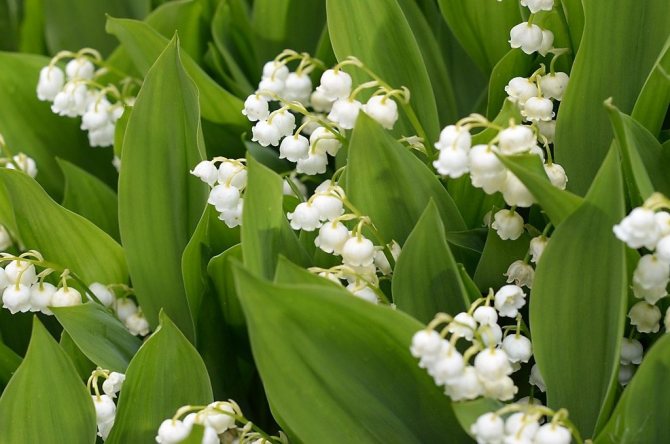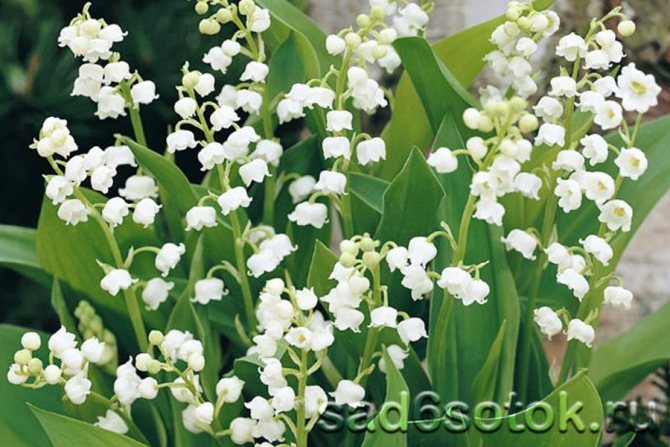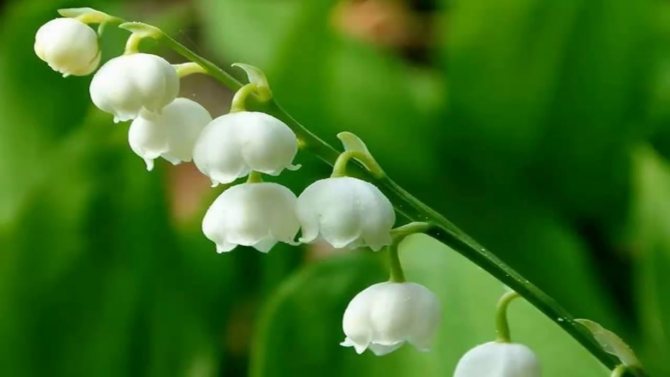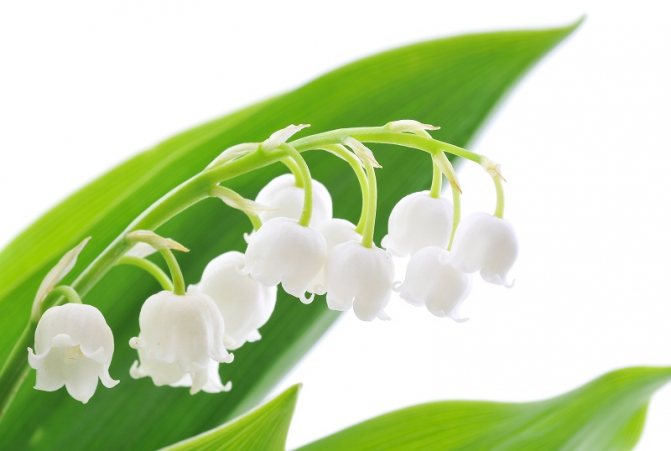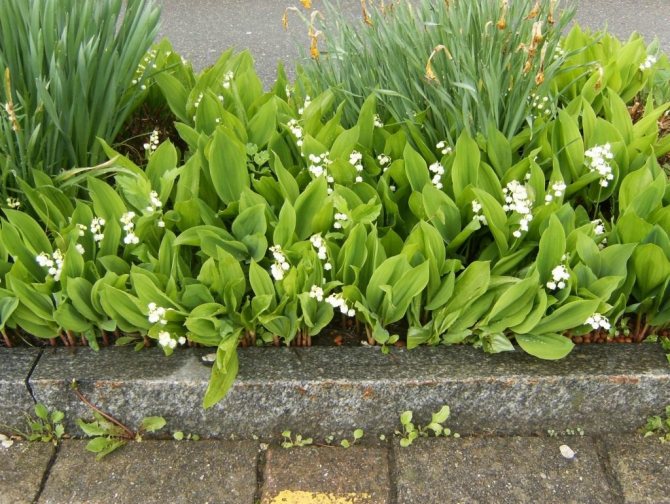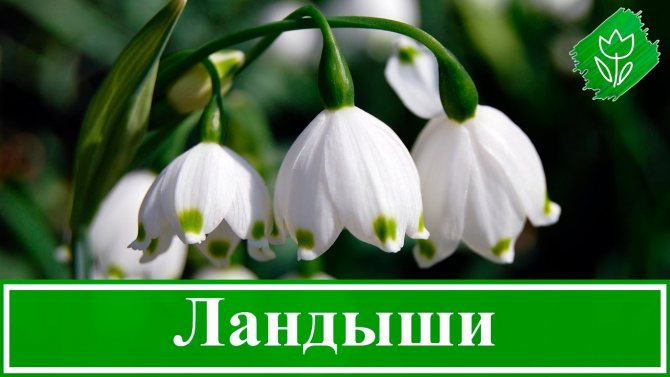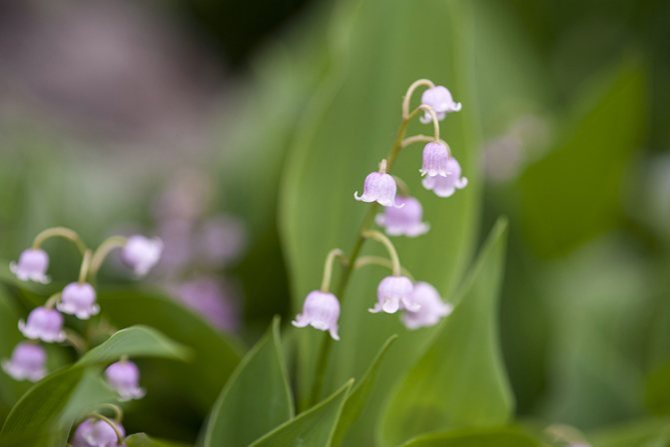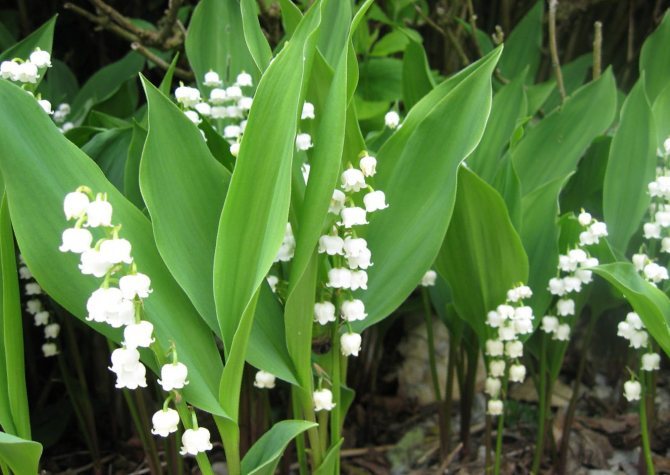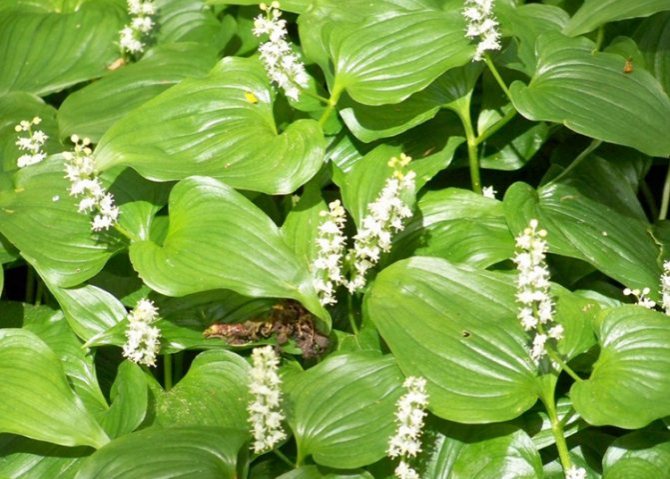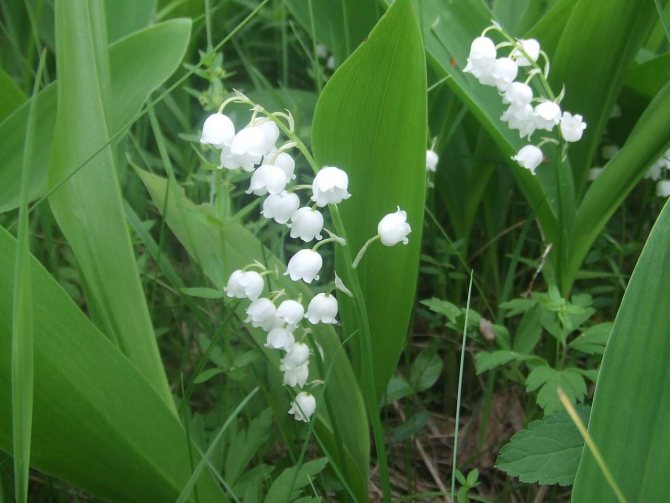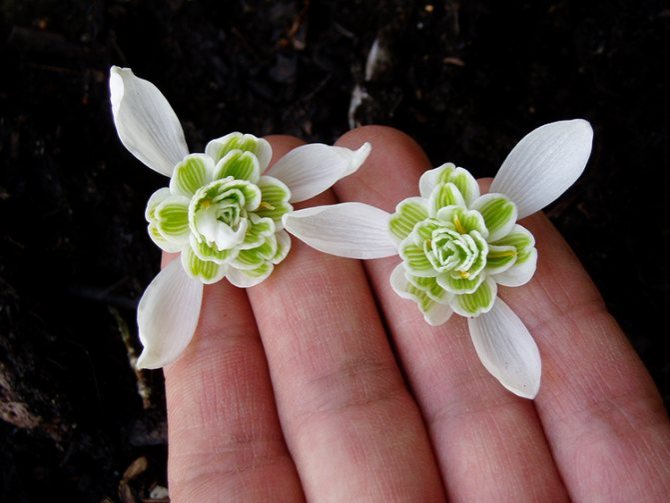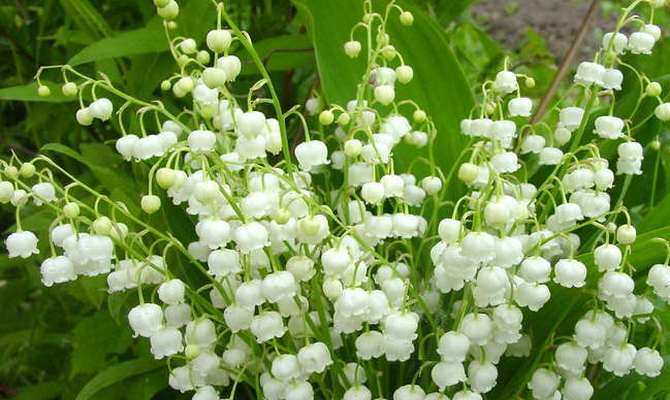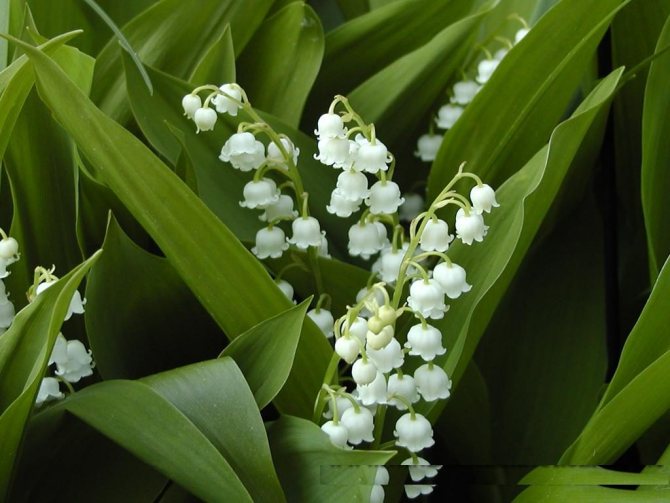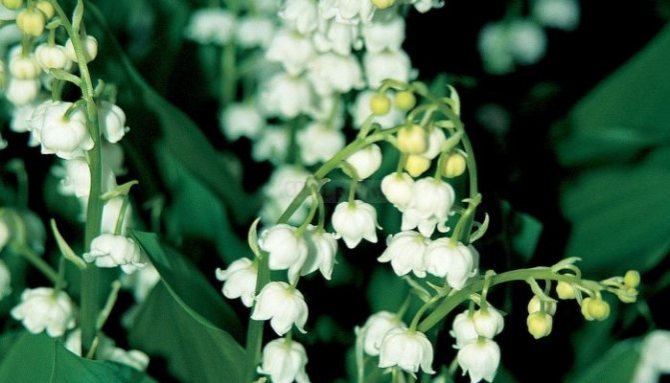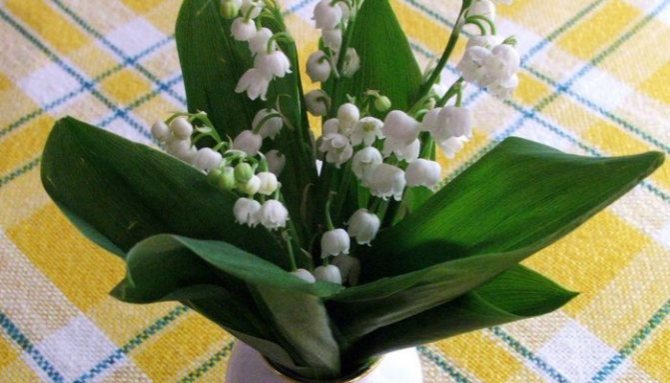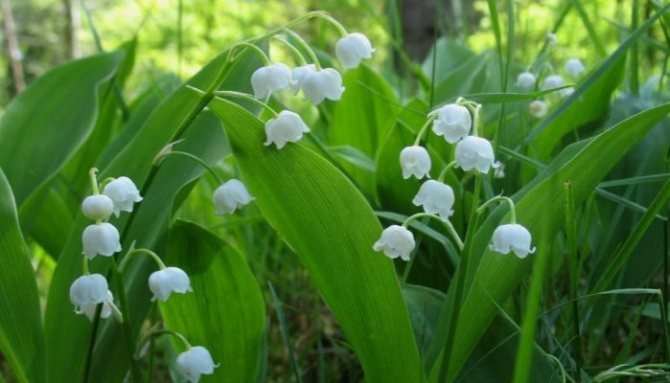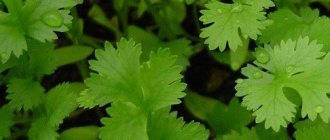May lily of the valley is a perennial, herbaceous, beautifully flowering plant that has spread in many regions of our country. This flower can be found in parks, mixed and deciduous forests, floodplain oak forests, in clearings and forest edges. Under favorable conditions, the lily of the valley rapidly expands in breadth, forming large fragrant clumps.
Growing lilies of the valley. The illustration for the article is used under the standard license <676 If you wish, you can dig up lilies of the valley in the forest and plant them on the site - in a flower bed or in a front garden. The main thing is to choose the right time for the transplant and follow the rules for care.
Growing a plant
It is better to choose a place for planting lily of the valley in the shade. He does not like bright sunlight, but it is also impossible to completely shade it, you can lose for the sake of which it was planted, beautiful white flowers. Not critical of the soil, he prefers when it is slightly acidic or neutral. If the acidity is high, lime treatment is necessary 250 grams per 1 m²
... Does not like wetlands and salt marshes, its preparation should begin a year in advance. Before planting flowers, the soil is kept under steam. Organic matter is introduced, gardeners mix manure, peat and humus in equal proportions.
You can plant lilies of the valley in spring and autumn. But in the first case, the plant will bloom only after a year. When to transplant lilies of the valley, the owner of the site decides. Therefore, it is better to plant lilies of the valley in the autumn, in the month of September. The exact moment of planting is determined by the color of the foliage, as soon as it becomes yellow, you can start working.
It is necessary to dig small furrows 10 centimeters deep, keeping a distance of 25 centimeters between them. When planting is done, 10 centimeters are laid between the flowers. Part of the root and shoots of the plant are placed in the holes. It is necessary that the root goes into the ground vertically. Above, a two centimeter layer of earth is required. Lily of the valley will delight the eyes for a decade, but after half the period, a transplant is needed for the plant.
Video "Garden lily of the valley, what is important?"
Lily of the valley care is not difficult. It requires keeping the soil moist, especially during dry periods, which he easily tolerates, but subsequently his flowers become smaller. At the end of summer, it is advisable to feed it with mineral fertilizers, and during the growing season, planting is mulched with compost, or Lily of the Valley loves loose soil and the absence of weeds, is able to stand up for itself, displacing other flowers from its territory.
After a period of flowering, the plant will adorn the area with luscious greenery until the end of summer. As mentioned earlier, lilies of the valley are invaders by nature, therefore, to prevent spreading to adjacent sites, for this, a flower bed with flowers is fenced, you can use any material, the main thing is to bury the sheets to a depth of about half a meter.
The lily of the valley tolerates winter cold with ease, in most cases it is not covered with anything. But if winter has come and there is not enough snow, soil mulching is required before frost. When frost appears in the spring, it is worth covering the plantation with polyethylene.
Lilies of the valley at their summer cottage
The forest flower loves well-hydrated nutritious soils. It is better to choose a place in the shade of large trees or bushes.Since the plant has a creeping root system, it will grow throughout the garden without outside help. To limit growth, plastic curbs from specialty stores are used.
Place for planting lily of the valley is prepared in advance. Fertilizers are applied:
- Deciduous humus or peat (10 kg per 1 sq. M).
- Mineral additives (superphosphate 100 g and potassium salt 40 g per 1 sq. M).
Planting grooves or holes are made, the depth of which depends on the size of the rhizomes. The sprouts are covered with a layer of soil of 1–2 cm. About 10 cm are placed between the plants.
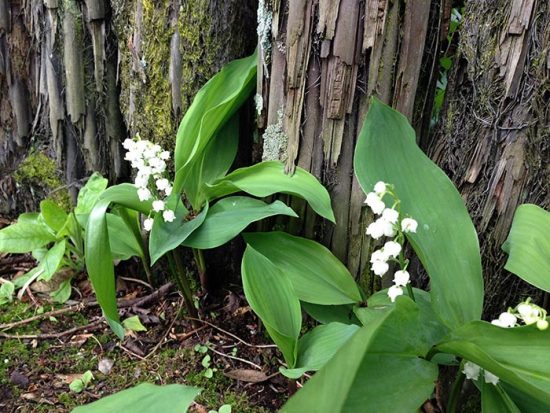
Planted in autumn, lilies of the valley will delight you with flowers in the first spring. Some people prefer to plant rhizomes "before winter". Lilies of the valley perfectly tolerate the most severe frosts - up to -40 ° C and do not need shelter.
Read also: How to make a garden shredder with your own hands
Lilies of the valley are very fond of organic fertilizing, they can be applied immediately after rooting. Plants will need minerals only after a year. In one place, May lilies of the valley can grow and bloom for more than 10 years.
At first, the planting will have to be weeded and loosened, the overgrown meadow of lilies of the valley does not need this.
Protection against diseases and pests
The disease that the plant most often suffers from is gray rot (fungus Botrytis dnerea), it quickly covers the plant with leaves and flowers. To get rid of the infection, watering with fungicides is required.
Also, lily of the valley lies in wait for gleosporia, from which spots appear on the leaves, bordered by a red line. If the spots are yellowish, this indicates the appearance of dendronema, appropriate solutions of fungicides are also used for treatment.
The plant also suffers from sawfly insects, in order to remove them, treatment with insecticides is required, if this is not done, these insects simply gnaw at the greenery of the plant. The greatest danger is carried by the nematode, affecting the root system. It is impossible to cure a plant from it, the only way out is to destroy diseased flowers. In order to prevent the disease, you can plant nearby or require the treatment of the soil with nematicides.
Reproduction of lilies of the valley
In the wild, flowers are propagated by seeds, but in the garden they have a rather low germination capacity, special soil is required. Another disadvantage of the seed method is the late appearance of inflorescences not earlier than 5 years after planting. Therefore, lilies of the valley are propagated in the garden in a vegetative way.
When August comes, you can start the process; for this, sprouts are used, the age of which does not exceed 3 years. A one-year-old plant will only produce two leaves, and a three-year-old will bloom the next year. It is possible to determine when the plant will bloom by its appearance if the bud is half a centimeter in diameter and they have a flat top, they contain inflorescences, thin and sharp will allow only leaves to grow.
The instruction is quite simple:
- An adult plant must be dug up. This is best done with a garden fork. The rhizome, buds and superficial roots are removed.
- The dug lily of the valley is cleared of the ground, a light rhizome should become visible. The plant is divided with hands or a garden knife. The planting unit includes a piece of root and at least two growth buds, if there are fewer of them, the plant may not take root.
- Divided bushes are planted on prepared soil.
How to plant May lilies of the valley from seeds: a quick guide
Every gardener will say that it is best to harvest tomato seeds and other vegetables yourself. But lily of the valley is not a tomato, and obtaining its seeds is even more troublesome than growing adult plants from them. Give preference to ready-made seed. Although it is not as easy to find it as sunflower seeds or asters, it is still possible on the Internet.
They said that the seeds of lily of the valley do not germinate well, so here's a piece of advice - order more of them.
On some bags, manufacturers indicate the germination rate up to 70% and the shelf life of the seeds up to 3 years.
But more often than not, this is more desirable than real, and this must be taken into account.
Before sowing seeds, they need to be stratified. This botanical term, which is difficult to pronounce, hides hardening. In other words, the grains need to be immersed in a winter sleep so that the subsequent rise in temperatures will be accepted as spring warming and will sprout together.
Such cold preparation should last at least 2 months. Pour the seeds into a bowl, and then fill it with snow and put it out in the cold. If snow is not found, you can replace "snow therapy" with simple hardening in the refrigerator.
Forcing plants
Lilies of the valley reproduce well at home. You can delight yourself with fresh flowers on New Year's Eve. To achieve this, as soon as the leaves turn yellow, the plants are dug up and divided into planting units; they must be stored until December in a dry place, the temperature should not exceed 4º. In mid-November, the plant can be placed in the refrigerator.
Then, when December begins, the seedlings are placed in warm water with a temperature of 35º, the roots are kept in such water for about 15 hours, some of them put the seedlings in a thermos.
Preparation of lily of the valley sprouts for distillation: a - lily of the valley sprout with rhizome, b - growth bud, c - flower buds, d - flower buds cuts, e - pruning of roots before planting, f - planting lily of the valley sprouts in pots for distillation, g - a pot with lily of the valley sprouts covered with moss
After the seedlings are planted in pots filled with sawdust, you can use special formulations that hold moisture well. The containers are placed in a dark place, the temperature in it should not be lower than 35º. There they are until the buds are moved, the plants are moved to a lighted area, gradually reducing the temperature to room temperature.
Popular name
Due to their unusual shape and delicate aroma, lilies of the valley are one of the most popular flowers, long loved by the people. It is not surprising that people gave this plant a variety of affectionate nicknames, reflecting not only its external characteristics, but also the beneficial properties that it possesses. Here are just a few of these names that have survived to this day: May lily; field lily; forest bell; forest language; canine tongue; hare salt; hare ears; May Day; rejuvenated; youngster; soapy grass; eye grass; the culprit; shirt; lanushnik; smooth; meadow cherry; raven; lumbago; silversmith; snow droplets; bells of Mary.
Did you know? It is noteworthy that the modern Latin name of the plant has survived since the time of the Swedish naturalist and physician Karl Linneus (1707-1778), who, in turn, modified the ancient Roman name for the flower - lily of the valleys (lilium convallium). And in English, Danish, Spanish and some other languages, lily of the valley is literally called the lily of the valleys today (Lily of the Valley, Lirio de los Valles, etc.). No less interesting are the names given to the plant by other peoples. For example: among Bulgarians, lily of the valley is the “tears of a girl”; for the Czechs - "bun"; the Germans have a "May bell"; among the Poles - "doe's ear" (because of the leaf shape similar to the doe's ear); the French and Italians have a "milkmaid" (respectively, muguet and mughetto).
RUNNING LANDYSH MAYSKY
You can admire the lily of the valley not only in May, but at any time of the year, as it is easy to distill. In autumn, the rhizomes of garden lilies of the valley with well-developed flower buds are selected. In appearance, such a kidney is blunt, thick, directed upward from the rhizome. Forest lilies of the valley are not very suitable for forcing, as they give small flowers or do not bloom at all
For forcing the rhizomes of lilies of the valley in May are dug in the garden after the first autumn frosts. It is more convenient to do this with a pitchfork, then the earth wakes up through the teeth. The central flower buds (they are thick and dull) are separated from the lateral vegetative ones; the largest of them are taken for early distillation, the rest - for later periods. Fold them "head to head", tie them into bunches of 25-30 pieces and trim all the roots by about a third. Before planting for distillation, rhizomes are dropped in sand or peat vertically in boxes and stored in greenhouses or in a cool room. The plants selected for early forcing are slightly moistened from time to time; with the onset of cold weather, they are transferred to the basement after a short freezing at a temperature of minus 5–6 ° C. Freezing makes forcing easier and more abundant flowering. Do not water the rhizomes during storage in the basement.
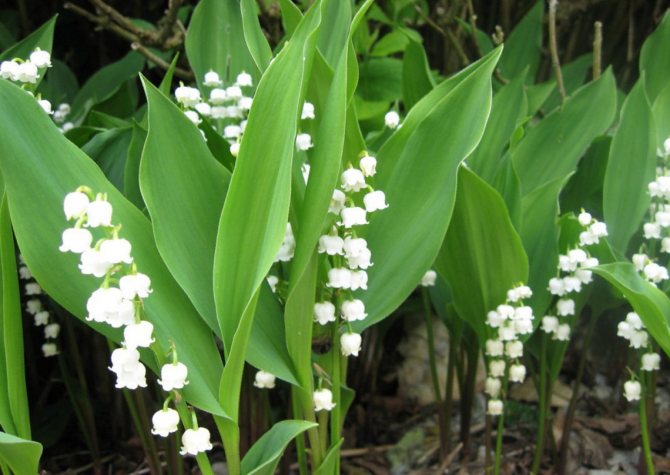

The first distillation can begin in December. At the rhizomes taken for planting, the roots are cut, leaving them 12 cm long, and immersed for 12-16 hours in water at a temperature of + 32-35 ° C. This speeds up flowering by 6-8 days. After the bath, the rhizomes are planted in pots with a diameter of 10-12 cm by 5-6 or in boxes of 25-30 pieces with a mixture of peat, turf soil and moss, covered with moss on top, placed in a dark place with a temperature of 25-30 ° C and often sprayed with warm water. They should be here before the buds appear. In room conditions, such a temperature can be created only by placing lilies of the valley near a heat source. You can darken it with black paper caps or an empty pot overturned on top. By the time large flower arrows are formed, the plants are exposed to the light, normal flowering begins. Distillation lasts 25 days. Blooming lilies of the valley can be moved to a cool place: they will bloom longer.
The quality of inflorescences when forcing in December can be improved with additional lighting. Fluorescent lamps are suspended above the plants at a height of 30 cm at the rate of 50 watts per square meter. Backlighting is done from 6 to 9 in the morning and from 4 to 22 hours. In this case, the leaves are colored more intensely, the peduncles are stronger.
For distillation after January 15, planting material is not treated with warm water, otherwise, to the detriment of flowering, the leaves grow strongly. Lilies of the valley are taken from the room where they were stored, and immediately planted. The temperature is maintained at 25 ° C, from February - 20-22 ° C. Closer to spring, the duration of the blackout is reduced. On bright sunny days, light darkening is required. Flowering occurs in 18–20 days. Lilies of the valley used in forcing are unsuitable for further culture.
Caution won't hurt
Lily of the valley is widespread, they are used in landscape design, amateurs planted by gardeners. The plant is used by herbalists, it is recommended as a sedative, to stimulate the heart, as a diuretic.
Despite its wide distribution, the plant is poisonous, you should not self-medicate, especially the manufacture of compounds from it. Gloves are required when working with the plant. It is imperative to explain to children that beautiful flowers and berries should never be eaten.
Video "May lily of the valley"
A plant similar to a lily of the valley, but no less healing - this is a kupena. It is used for cardiovascular diseases, for pain in rheumatism. But she's not so poisonous. Harvesting must be carried out at the beginning of June.
Lily of the valley flowers in their appearance resemble charming delicate bells, which are fragrant for quite a long time.
Their aroma is very pleasant and unobtrusive.
Lilies of the valley wake up immediately after the snow melts, so the flower bed or tree around which these beautiful flowers grow will clearly become a place of attraction for your eyes.
In August, after flowering, the berries of the lilies of the valley begin to ripen - they are poisonous!
Be extremely careful if kids or pets are running around on your site. It is better to remove the berries.
What to do after flowering?
Lilies of the valley are aggressive plants. Despite their external fragility, they have excellent "penetrating" properties and are very actively distributed. By planting just a few roots in the ground, you get a lawn filled with fragrant grass.
These flowers are able to outlive almost any plant from the garden. Therefore, after flowering, carry out procedures to restrain development. To this end, enclose the flower beds with sheets of slate, iron or other similar material. Fence the flower beds in such a way that the slate goes to a depth of about half a meter.
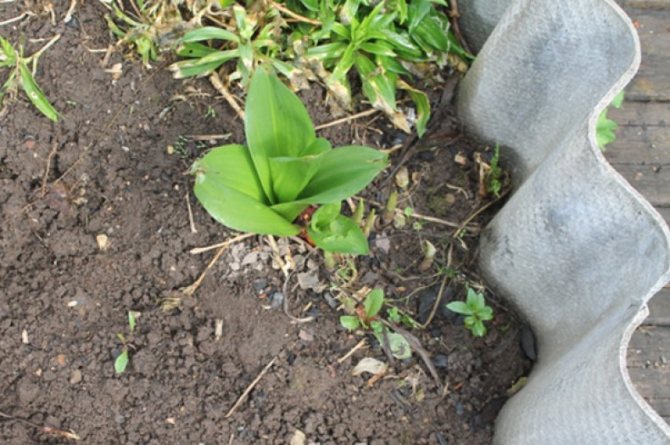

Place and soil for planting lilies of the valley
Choose a slightly shaded area for planting lilies of the valley so that bright sunlight does not fall on the flowers. However, a solid shadow can harm plants - there will be no flowering.
They grow well on drained, slightly acidic soils with a pH level of 5. Light loams are excellent. If necessary, carry out: distribute 200-300 g of lime for each square meter. In the summer, it is good to plant a site under lilies of the valley with legumes, in the fall to remove without pulling out the roots. Then weeds will not interfere with the growth of flowers. In one place, lilies of the valley grow and bloom for 5-10 years.
Planting lilies of the valley
Usually, lilies of the valley are planted in the fall (September), but if you have a place for storing sprouts with a maintenance temperature of 0 ... + 2 ° C, then spring (April-May) is also suitable for this.
These flowers have a powerful root system, which is shallow, but at the same time grows well and branches out in breadth. Therefore, fence the area for planting lilies of the valley with sheets of iron or slate up to 20 cm high, digging them around the perimeter to a depth of 10-15 cm.
Loosen the soil and make grooves so that when planting rhizomes, the shoots are covered with soil by 1-2 cm, while the root system should be free, without bends. Observe the distance between the plants 10 cm, and between the grooves 25 cm. Thickened plantings promote the development of gray rot.
At home, you can do it in winter, although after that they will no longer be suitable for planting in open ground. For forcing, choose large shoots with a rounded flower bud.
Lily of the valley care
- Water the soil in a timely manner, avoid drought, so that the flowers do not begin to shrink. Due to a lack of moisture, lilies of the valley may not bloom next year.
- Avoid the appearance of weeds in a flower bed with lilies of the valley.
- Feeding with organic fertilizers is appropriate 1 month after planting. It is better to refrain from fertilizing with mineral fertilizers in the first year of growth.
- To distract nematodes from the roots of lilies of the valley, you need to close to plants, the aroma of which will not allow the pest to get close to the flowers. If a nematode is affected, the plant must be removed.
- No shelter is required for the winter. Thinning every 3 years to keep blooms large.
Reproduction of lilies of the valley
The easiest way to reproduce is by dividing the rhizomes. To do this, in August, a part up to 6 cm long is separated from the rhizome, so that it has processes and an apical bud.
The seed method of propagation is not popular and successful with flower growers due to the very low germination of flowers. But if you decide to try, then you can sow 2 times a year in April and September. Transplant to a permanent place during the period when the leaves begin to turn yellow.
Lily of the valley
Is a perennial plant with a creeping rhizome of the Liliaceae family. Lilies of the valley are spring flowers associated with the arrival of the most beautiful time of the year. Small bouquets of lily of the valley are available in May or early June. But in order to enjoy the scent of lily of the valley, it is not at all necessary to buy a bouquet from enterprising old women or go into the forest in search of it.
Lily of the valley
can be easily grown outdoors in your garden or in your summer cottage.
With the arrival of spring, blooming lilies of the valley intoxicate with aroma and charm with the tenderness of flowering. Lilies of the valley are recommended to be planted where their aroma can be quickly noticed, namely along garden paths, near gazebos. In this case, it is imperative to take measures to curb the growth, otherwise the strong roots of the lily of the valley can somewhat spoil the appearance of the track cover. After the lilies of the valley have faded, they do not lose their decorative effect due to the bright curtains of thick juicy leaves. Despite the fact that lilies of the valley are not very fond of the neighborhood, they can be used in joint plantings with crops that have a shallow root system and multiplying layers and mustaches: tenacious, zelenchuk, spring umbilical and aquilegia. Planted together, they will create a spectacular picture of a real forest forbs. designed in this way look more natural than monoculture planted. Currently, many varieties of lilies of the valley have been bred, differing in the shape and color of flowers. Basically, lily of the valley is used as a ground cover plant and for forcing.
Choosing a place
Before planting any plant, you need to choose a place, this is where information about it and the recommendations of experienced florists come in handy.
We are talking about forest flowers, so the main thing that they need is shade and a sufficient amount of moisture. Plant them where other flowers are not comfortable, and you will see the result will be amazing. But, thick shade can cause intense foliage growth and lack of flowers, therefore, if possible, choose partial shade.
Like most flowering plants, they do not like wind and drafts, lilies of the valley will not die, but they will not please you with their flowering. So, choose a place near a large tree or bush, under the wall of a house or near a fence.
The most effective way to propagate these plants is by rhizome propagation. Having planted lilies of the valley once, you will be surprised to notice that every year young plants appear in new and new places. When flowering is over, small red fruits can be found in which there will be seeds, but using the latter as planting material usually does not give a good result.
In addition to beautiful, delicate flowers that resemble bells, lilies of the valley have another advantage - a delicate aroma. Therefore, it would be wrong to plant them in the far corner of the garden, or in another deserted place. The pleasure of the scent of flowers should be available to both you and your guests, so plant them near the garden path, near the gazebo, under the window. But, be prepared for the fact that in a short time their area will increase significantly, and the growth of the root system can lead to the appearance of cracks on any surface. The green, juicy leaves of the correct shape will be an excellent decoration of the site, even after the fragrant lilies of the valley have faded.
Not all plants can withstand such seemingly cute and defenseless flowers. But in tandem with lamb, aquilegia or zelenchuk, it is good for all plants.
As we said, growing lilies of the valley is not difficult, even beginners can do it. The main thing is to plant them correctly.
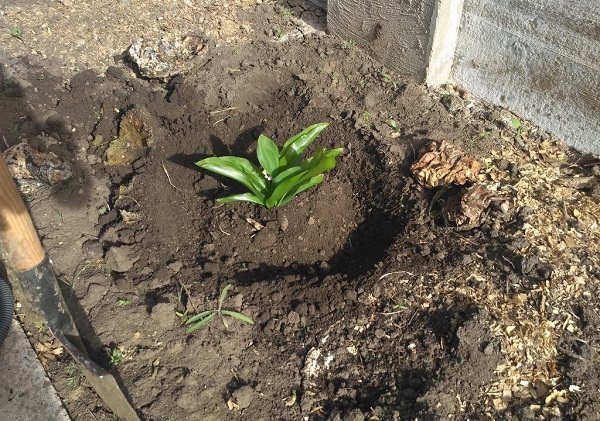

Growing and caring for lilies of the valley in the garden
This unpretentious plant does not require painstaking care. It is enough to plant lilies of the valley at the right time and you can forget about caring for them. Even left to themselves, they grow and bloom beautifully for several years.
Seat selection
... Lily of the valley is a forest plant, it loves moisture very much. To make lilies of the valley feel "at home", that is, in the forest, they need to be planted under trees or shrubs. The plant is shade-tolerant, and you can even say that moderate shading is good for it. But in the dense shade, the lily of the valley ceases to bloom and throws all its strength into growing leaves.Wind is another barrier to plant well-being.
Lily of the valley
is afraid of strong winds, and if the area on which it grows is well ventilated, then the plant will grow and bloom poorly. The planting site for lily of the valley should be protected from the winds by tall trees, shrubs, a fence or a building wall.
Reproduction
... Lily of the valley reproduces by underground rhizomes, and very quickly and without human help.
Lily of the valley
does not like frequent transplants, therefore, once planting a plant, it is better not to touch it anymore.
Planting and transplanting. Planting and transplanting lily of the valley should be carried out only in the fall, namely in September - October. Before planting, you need to dig deep into the soil, fertilizing it with humus. Rhizomes with buds or leaves in their infancy are suitable for planting. The rhizomes are planted so that the roots are not bent, and the sprouts are covered with earth by 1 - 2 cm.The planting pattern is in rows, the distance between plants in a row is about 10 cm, and between rows - 20 - 25 cm.
Curbing overgrowth
... This plant with delicate flowers and graceful aroma, despite the external fragility, has truly excellent "punchy" qualities. The beautiful lily of the valley is able to survive any plants, except for trees and shrubs, if they find themselves in the territory that is included in his plans to capture. The lily of the valley owes this quality to its powerful root system, literally braiding the entire surface of the soil 40 cm deep. So that there is still something in the garden besides the lily of the valley, it is useful to hold an event to curb its growth. To do this, you need to fence the flower bed with lilies of the valley with sheets of slate, iron or other similar material, so that the fence goes to a depth of about half a meter.
Watering
... In order for lilies of the valley to bloom well and regularly, when grown in the summer heat, they need to be watered so that the soil is moist all the time.
Fertilizers
... Lily of the valley responds well to soil fertilization with manure or humus.
Useful information for gardeners about lilies of the valley
Lily of the valley can be called an invader plant that stubbornly conquers territories from neighboring flowers. They have a very well-developed root system, which, at a depth of 40 cm, enmeshes the entire space with its plant cobweb.
Read also: How to plant sedum (sedum) Morgan
If there is an intention to plant lilies of the valley in the vicinity of other plants, it is recommended to enclose them with restraining materials deepened by 50 cm. So you can dig in sheets of slate, stone or other decorative materials.
As mentioned above, lilies of the valley love moisture, so they should be watered abundantly during the dry summer months.
There is no particular need to fertilize lilies of the valley, but the plants will be grateful for organic feeding.
Like other plants, lilies of the valley can suffer from several diseases. Vegetable rot can be especially troublesome for the plant. At the first signs of this disease, it is recommended to treat the plant with fungicides.
Despite its pleasant appearance, the aroma with lilies of the valley should be on the lookout, because all its parts are saturated with vegetable poison. Especially dangerous are red berries that form in the place of inflorescences. This is one of the good reasons why it is worth leaving lilies of the valley in place of their growth, and not hoisting them into a living room. It is especially not recommended to leave a bouquet of lilies of the valley in the bedroom, so as not to feel unwell later.
Diseases and pests of lilies of the valley
The disease that lies in wait for lilies of the valley is gray vegetable rot. To rid plants of it, it is necessary to resort to the help of fungicides. can be affected by pests - nematode, sawflies and onion cracker. Plants affected by nematodes must be destroyed. In order to prevent plant diseases in the future, as well as to protect lilies of the valley from pests, prevention is needed - weed control.
Caution
! All parts
Most of us know this plant as a garden lily of the valley.His photo is associated with cleanliness and spring. The name of this flower comes from the Latin phrase, which translates as "valley of lilies".
general information
This culture is widespread in the temperate climatic zone, although some of its varieties are also found in the tundra or forest-tundra zones. Lily of the valley as a genus includes some with well-developed, branched, cord-shaped roots. They are often used for forcing in winter.
Today, garden lily of the valley has become quite popular with summer residents. He found his place in the secluded and slightly darkened corners of the sites. It is usually planted in large groups. Many people use garden lily of the valley as under trees or shrubs. It is known that this flower is rarely used in flower beds or mixborders, since it is somewhat aggressive and can crowd out its neighbors.
Lily of the valley when the month blooms
As in ancient times, the alliance of the enchanting scent and impeccable forms of lilies of the valley find their admirers among sincere fans of spring flowers who want to grow these amazing flowers on their site. However, few people know that this fragile and charming flower has certain care requirements that allow you to achieve its beautiful flowering, not only on the backyard, but also on the windowsill of our apartments.
As in ancient times, the alliance of the enchanting scent and impeccable forms of lilies of the valley find their admirers among sincere fans of spring flowers who want to grow these amazing flowers on their site. However, few people know that this fragile and charming flower has certain care requirements that allow you to achieve its beautiful flowering, not only on the backyard, but also on the windowsill of our apartments.
Caring for garden lilies of the valley
Despite the outward refinement, lilies of the valley are quite persistent garden flowers, which in most cases are not afraid of either weeds or severe frosts.
Landing place. In gardens and in backyard plots, it is better to plant lilies of the valley under large branched trees or shrubs (lilac, elderberry, bird cherry), which will protect these delicate flowers from direct sunlight.
The soil
... Lilies of the valley are quite demanding on the soil, which, for the most part, should consist of leaf humus, moss and peat.
Watering
... One of the wettest moments when growing lilies of the valley is to ensure constant soil moisture. Therefore, in the summer, it is necessary to constantly monitor that the soil around the flowers is slightly moistened, otherwise the lilies of the valley will be crushed and bloom worse.
In the landscape
The large garden lily of the valley is very beautifully combined with ferns, lungwort, catchment and anemone. In this case, you should not dig up and bring home the forest varieties of this plant. According to many, it is the garden lily of the valley that looks much more effective. A photo of this flower can often be seen in the form of a very simple but elite bouquet, including a wedding one. For this, half-open peduncles are selected. At the same time, experts recommend not cutting them off, but simply pulling them out. However, it must be remembered that almost all varieties of lily of the valley are distinguished by the release of milky juice, and therefore it is better not to combine them in bouquets with other flowers.
Use in medicine and landscape design
Lily of the valley is widely used in decorating parks and gardens. This plant is not suitable for a round small isolated flower bed, but rather finds application for a continuous soil cover. Looks good with ferns and aquilegia. The plant is popular with perfumers, but it is difficult to get a natural smell from flowers, therefore chemical compounds are actively used to recreate the scent of a flower.
Read also: Protection of lilacs from dangerous pests and diseases
We recommend that you familiarize yourself
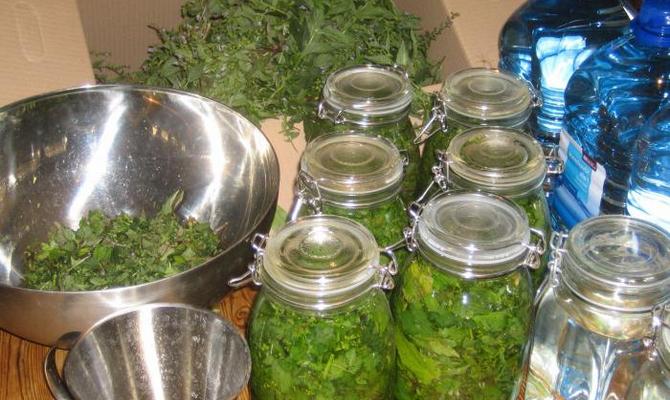

Lily of the valley tincture
Description
The plant is very widespread not only in our country, but in Europe and North Asia. It is also found in North America.
The genus of lilies of the valley is a stunted culture. Its representatives have creeping branched rhizomes, from which the upper - green part departs. Pale lower leaves are located in the soil, while terrestrial vaginal leaves have a long, wide shape with a pointed tip. They are arranged in four to six pieces.
The upper surface of the leaves is matte, while the lower surface is shiny. The plant has a triangular stem that grows in height in some species up to fifteen to twenty centimeters. However, in some cases, it can reach 40 cm, such as a tall garden lily of the valley. There are white flowers on it, the corolla of which is six fused petals. The most common species in the wild is
What does it look like
To better understand what a lily of the valley looks like, we give a botanical description of the plant and show how the May lily of the valley looks in the photo. This herbaceous plant reaches a height of 30 cm.
Lily of the valley rhizome is long, thin, creeping. Numerous processes extend from the main root. Pale leaves are located at the base of the plant.
Shortened shoots. The plant has two, less often three, whole broad-lanceolate leaves, between which a flowering stem is located.
The lily of the valley cluster-shaped inflorescence consists of 6-20 pale yellow or white flowers, similar to bells. Larger flowers are located at the base of the inflorescence. Towards the top, they decrease. Lily of the valley blooms from May to June.
Fruits are spherical bright red or orange-scarlet berries, up to 8 mm in diameter. They contain one to two round seeds. Lily of the valley berries ripen from June to July.
Loading ...
We have described the appearance of a lily of the valley. Now we will tell you where the lily of the valley grows, what climate and soil it prefers.


Garden views
Several garden varieties have been bred from the plant by selection, differing not only in the characteristics of the flowers, but the stem of the plant is also a peduncle at the same time, Despite its height, wide leaves are attached by means of sheaths, which are white or pink, and therefore they seem to bend to the ground.
The garden lily of the valley resembles a brush with its inflorescence, on which small drooping flowers, numbering from five to twenty pieces, are placed in one-sided form. At first glance, they look very much like miniature bells with their base down. Despite such a small size, garden lily of the valley exudes a very pleasant and delicate aroma that can be carried far enough.
In the Caucasus, another variety is very common - the Transcaucasian, or Convallaria transcaucasica. It is hardy and grows well in culture. For the normal development of this species, a shaded area is required.
In the southern regions of the Far East, you can find another variety of May lily of the valley, which is called "keyzke". It differs from the main species in dark green large leaves, as well as larger flowers and a late growing season.
Popular varieties
Previously, it was believed that the genus of Lilies of the Valley consists of only one polymorphic species - May. Based on the geographical fragmentation, some lilies of the valley were distinguished into autonomous species, while the biological characteristics differed very little.
In today's classification, it is customary to distinguish three biological species of the genus:
- Maisky (Europe and the Caucasus);
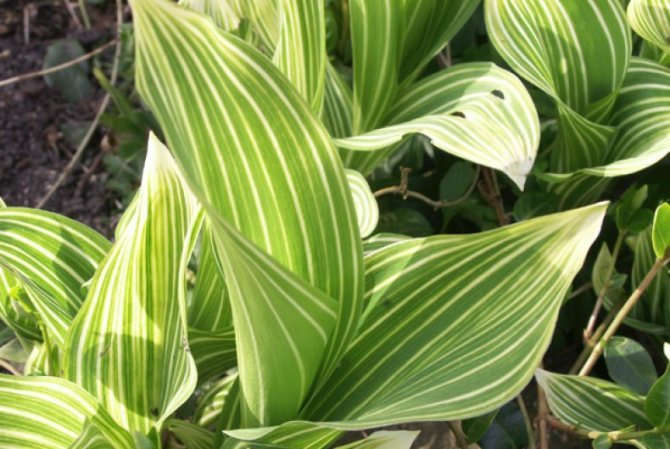

- Mountain (USA);
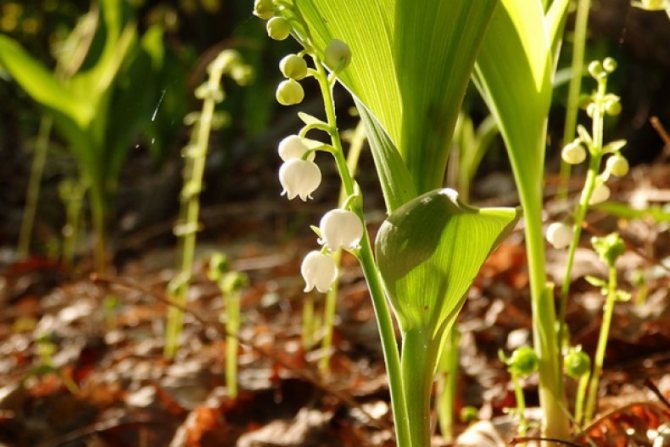

- Keiske (North and East Asia).
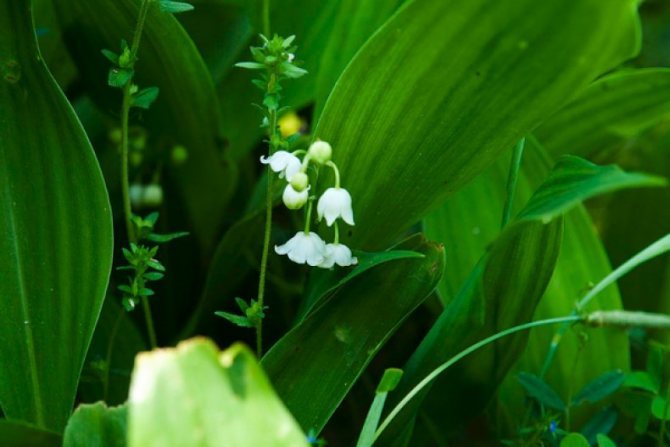

In decorative floriculture, lilies of the valley have been bred since the XY century. Several garden varieties have been bred:
- "Rosea" - has light pink inflorescences;
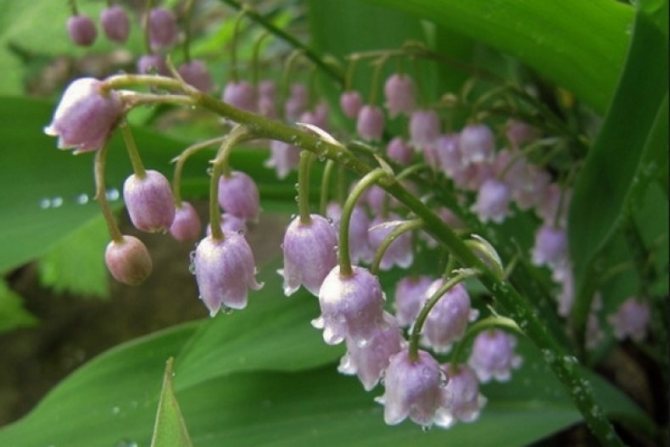

- Alba Pleno (Flore Pleno) or Alba Plena (Flore Plena) - has large white terry inflorescences;
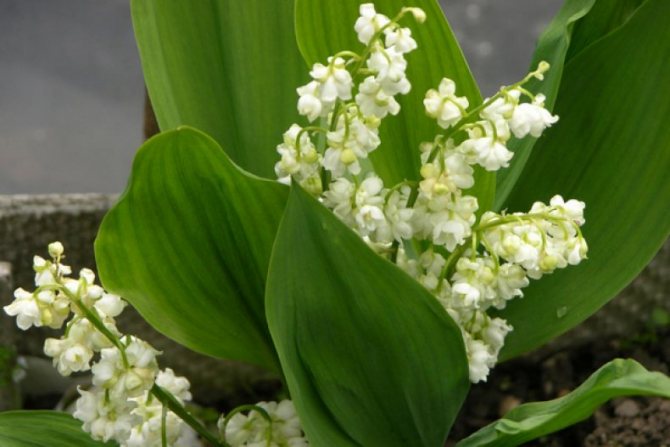

- "Grandiflora" - stands out in large inflorescences;
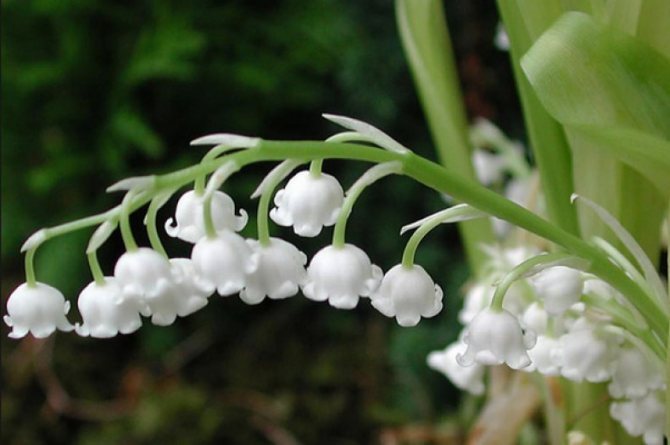

- "Albostriata" - the leaves of the plant have creamy white longitudinal stripes;
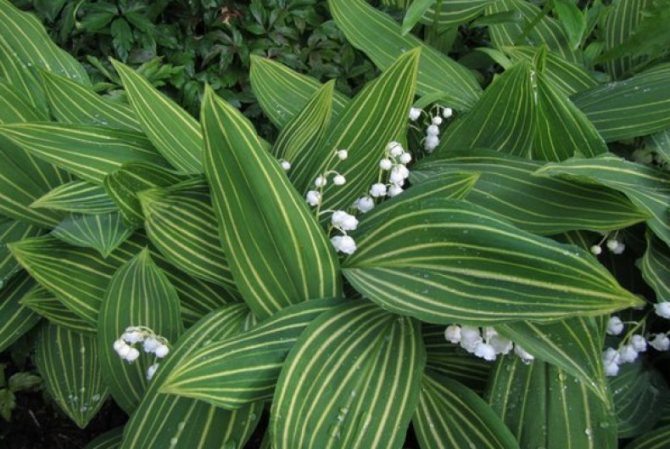

- "Picta" - with purple spots at the base of the filaments;
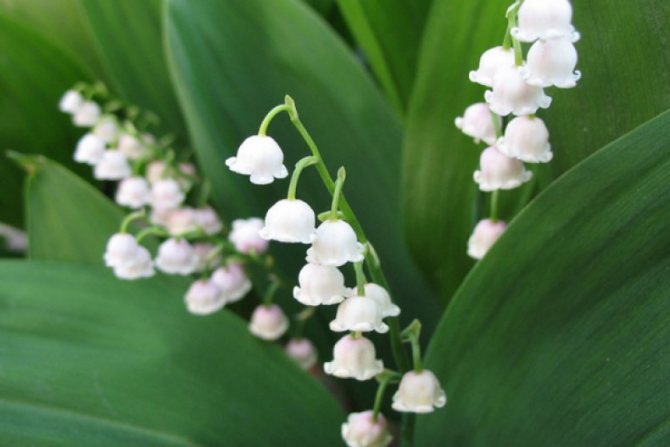

- "Prolificans" - differs from other forms by branching pedicels forming crowded inflorescences;
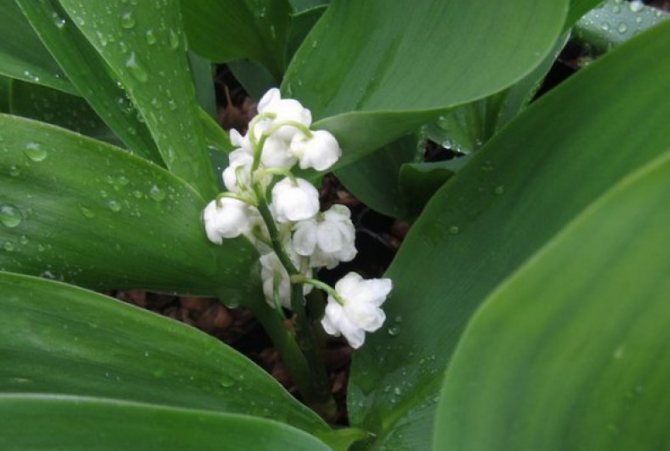

- "Aureovariegata" or "Lineata", "Striata", "Variegata" - distinguished by yellow longitudinal stripes on the leaves.
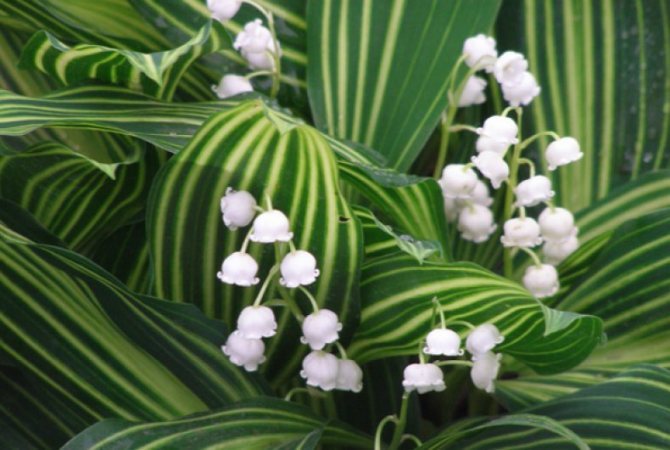

Growing
Despite the fact that this plant grows mainly in forests, especially in shady meadows, many amateur gardeners today widely use it as a cultivated species. The first mention of the plant dates back to the middle of the sixteenth century. Even then, in Europe, they began to grow garden lily of the valley. Planting and caring for it does not require special skills, however, this flower must be handled very carefully, since the pleasant aroma that comes from it is very deceiving. The fact is that lily of the valley, including garden, is considered to be used only in medicine and less often in cosmetology.
Although garden species have a certain similarity with their "wild" relatives, they are nevertheless distinguished by the color of the leaves - green-yellow, as well as the color of the flowers. Their appeal lies in the fact that even after they have finished blooming, they still retain their decorative qualities provided by the large green leaves. However, in order for them to always be healthy and delight with their lush flowers, when growing them, you should be guided by the rules that are required for a plant such as garden lily of the valley.
The poisonousness of the convali
Despite the fact that the first lily of the valley in May outwardly seems to be an extremely fragile and delicate creature, it may well stand up for itself: lilies of the valley are the first flowers in May - completely poisonous plants.
They contain konvallatoxin - an extremely strong poison of plant origin, affecting both the cardiovascular and nervous systems, as well as the gastrointestinal tract. Cats are especially sensitive to it: a lethal dose for them is 0.04 mg / kg.
People can also be poisoned by a convoy. Considering that the taste of lily of the valley in May is extremely bitter, hardly anyone will have a desire to eat it in large quantities (and this will definitely save his life). Poisoning mainly occurs when ingestion of medications prepared on its basis without consulting a doctor.
In the case of mild poisoning, a person may experience vomiting, diarrhea, headaches, and cramps in the stomach. If the case is more serious, the patient's heart begins to stop, the pulse becomes less frequent, the nervous system is affected (up to seizures, vision problems and loss of consciousness). This condition is so dangerous that the heart can break down and stop forever.
If there is a suspicion of poisoning with a drug made on the basis of convallatoxin, it is necessary to immediately wash the stomach.
This plant is not poisonous for everyone; convali berries in winter often save birds from starvation. Also, moose and deer eat the first lily of the valley with pleasure without any harm to their health. She loves forest lilies of the valley and the fox, she often climbs into their thickets, sniffs flowers and often "gets drunk" at the same time.
Planting and leaving
Photos of this amazingly delicate flower can be seen in almost every gardening magazine. And this is not surprising: his snow-white graceful miniature bells evoke a feeling of tenderness and some kind of childish delight.
In order for the garden lily of the valley, which is not difficult to care for, to feel good on the site, you first need to choose the right place. Planting should be done in semi- or full shade. The soil should be slightly loamy, rather moist and slightly acidic, although the plant feels good on neutral soil. Preparation of the site for disembarkation should begin somewhere in the middle of autumn - in October.
The ideal time for outdoor use is autumn (September) or spring (mid-April). Moreover, in the first case, planting should begin after the leaves on the trees turn yellow. The place should be chosen in the shade. The easiest way is to plant lily of the valley in sprouts, although propagation by seeds is often practiced. The planting material is represented by small sprouts that have rhizome processes and leaf rudiments or flower buds. Before placing them in the ground, having thoroughly loosened, you need to make grooves in it up to fifteen centimeters deep. In the process of planting, you need to carefully ensure that the roots do not bend, and the sprouts themselves should be sprinkled with earth by two to three centimeters.
The algorithm of actions is very simple.
- The soil needs to be prepared, well dug up, humus added. When choosing between organic and mineral fertilizers, it is better to give preference to the latter.
- Any rhizome can be chosen as planting material? Of course not. The presence of buds or leaves in their infancy is the main sign that this material is suitable for planting. By lowering it into the ground, you need to straighten the roots well. Sprinkle the sprouts with soft and moist soil, but no more than 1.5-2 cm.
- Experienced growers advise planting these flowers in a row, the distance between the rows should be at least 20 cm, and 10 cm between the bushes.
Features of planting and growing
It is necessary to plant planting material in rows, at a distance of ten centimeters between seedlings and thirty - between rows. If the lily of the valley was correctly placed in the ground, then in this area it will grow for at least ten years.
Moreover, in the first year after planting, only those shoots with a diameter of more than six millimeters and a slightly rounded top will bloom. The rest will only have leaves.
Young garden lily of the valley, planting and caring for which were carried out in accordance with the norms of agricultural technology, it will be enough to overlay with rotted manure. When the planted sprouts take root, and this happens around the thirtieth day, you should fertilize with organic fertilizers.
Choosing a place on a personal plot
Lily of the valley is a forest grass. To make the lily of the valley feel at home on your garden plot, you must follow the rules of cultivation and care, as well as choose the most comfortable zone for flowers.
Location and light
Lilies of the valley prefer a shaded location. However, the shading should not be heavy, otherwise the flowering will stop. In a continuous shade, the plant gives all its strength to the growth of leaves.
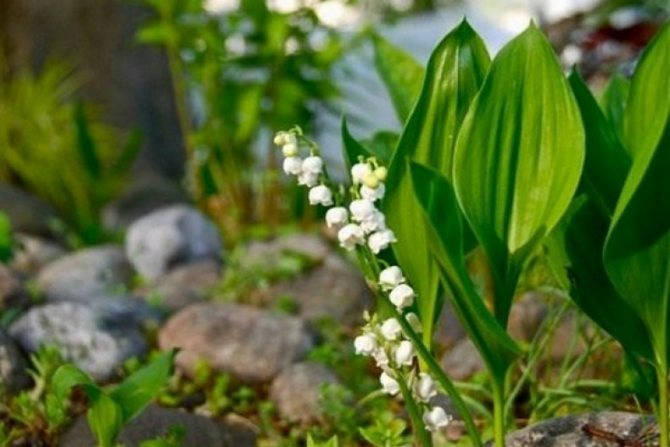

Plant flowers under trees or bushes. Also, avoid overly lit areas that are exposed to direct sunlight. Overheating of the soil in the area of the roots negatively affects their growth.
It is also known that lilies of the valley do not like strong winds. A fence, a house wall, and tall trees and shrubs will help protect the plants.
Soil for lilies of the valley
It is advisable to prepare the substrate for planting in advance, a year before planting or in the spring. The cultivated soil layer should be quite deep (25-30 cm).
Read also: Gray fescue: description, planting and care
Lilies of the valley give preference to well-drained, light or medium loamy, cool, moist, slightly acidic soils (pH 5). But the plant also grows well on neutral soils. Strongly acidic soil is lime in advance.
In addition to lime, add peat compost, manure or humus, as well as some simple superphosphate and potassium sulfate. In the summer, keep the area under a fallow, do not let the land overgrow with weeds. Do not forget to loosen the soil before planting.


Distillation
For lush flowering, lilies of the valley need distillation. To do this, you need to dig up the plant immediately after the frost. Rhizomes for distillation are selected with leaf ovaries.The shortest and thickest specimens, with the presence of blunt buds, are planted in pots, and the rest are returned to the garden.


In autumn, at home, they are kept in soil with a nutrient composition. The pots are exposed in a cool place, where they are kept until January. The room temperature should be no higher than four degrees Celsius. In early February, the pots are transferred to a windowsill with diffused lighting. Since that time, the lily of the valley, starting to prepare for flowering, increases its leaf mass. In order for the plant to bloom faster, it must be covered with snow at night before entering the room.
Watering
The plant needs constant moisture, otherwise it will bloom poorly. In dry summers, garden lilies of the valley should be watered twice a week. There are few weeds around them, since they themselves are able to survive other plants, nevertheless they are. They must be removed manually after each watering.
You do not need to cover lilies of the valley for the winter: these flowers are quite frost-resistant. Once every three years, they need optimal thinning of the plantings, since if too dense, flowering can stop.
Fertilizer
In this case, the soil should be dug deep enough - thirty to forty centimeters. If the land on the garden plot is highly acidic, then lime must first be added to it: three hundred grams per square meter. In addition, you need to add manure or compost: ten kilograms per 1 sq. m. It will not be superfluous to introduce a small amount of superphosphate from Fertilizers applied to the soil should be thoroughly mixed with the ground.
Moreover, they need to be added twice a year: the first time during a thorough digging of the site - in October, and the second - in the spring. And with the onset of summer, when the garden lily of the valley - fragrant, as it is also called, is already fading, the site needs to be cleared of weeds. In addition, crops such as beans or peas can be planted here.
Of the diseases, garden lilies of the valley are most susceptible to gray rot, which can be eliminated with the help of special products sold in gardening stores. The pests of this flower are the sawfly and the onion cracker. In case of infection, the diseased plant should be destroyed immediately so that it does not infect neighboring bushes.
What kind of care will the flowers need?
Naturally, plants need compost and organic fertilizers. Humus is applied in August, and mineral fertilizers are not applied at all in the first year, but they do it later. Otherwise, the flowers do not require special care in terms of feeding. In the spring, fertilizers are usually applied in liquid form, and once is enough. As a result, large leaves and flowers will appear very quickly, and flower buds will form in a larger size.
Watering flowers on the site
It is important to monitor soil moisture. Its excessive dryness will lead to the death of the roots. Stagnant water and high humidity are also detrimental. Therefore, water the plant throughout the summer when required. Large flowers require a lot of water to appear, but there should be no puddles. With good care, the bush blooms 3-4 times a year. It is also necessary to restrain the growth of weeds and remove them in a timely manner, therefore, it is advisable to remove the grass after watering. Initially, the plants need to be weeded every time after this operation, and when they grow, they will be able to displace the weeds on their own. They pull out the excess near the flowers, as a rule, with your hands, carefully, protecting the root system. During such care, there is no need to loosen the soil, if the weeds do not have time to grow, then, by taking them out every time, you will already create good channels for air exchange.
When the lilies of the valley have matured a little, there is no need to clean them after each watering, weed twice a month during the year. After all, not only weeds, but even the most common grass significantly harms the growth with its roots. Watch the temperature as the flowers take root well and grow in cool weather.If it's hot, create a shade, when watering it is better to take colder water, but do not try to put it in the refrigerator. The health of the plantation will also be improved by transplanting, they are engaged in it after five years of flowering. Usually in the spring, the overgrown rhizome is divided and the bed is formed again. The roots are selected in such a way that the buds and leaves have not yet blossomed.
On average, lilies of the valley are usually grown for about 10 years, then they stop blooming. To prolong flowering, the beds are periodically renewed in a natural way. Part of the bed is dug, leaving an empty space, they are monitored in the same way as for a regular bed. The vacated plot is overgrown again, but with young growth. This is best done every three years. For the health of the garden, it is important to periodically induce cosmetic beauty by removing wilted and broken bushes and leaves. This helps to maintain plant growth, cleanliness, and a beautiful appearance of the flower bed.


